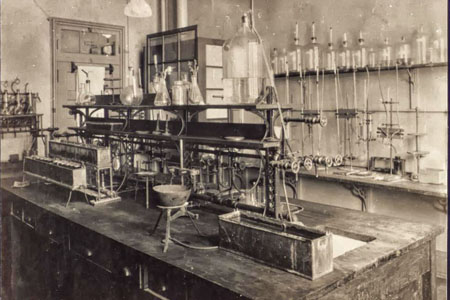Childbirth is the beginning of a child’s life and a powerful rite of passage for the mother. Methods vary according to culture and time periods. Before the 19th century, Canadians relied mostly on the help of midwives, as well as prayers and even superstitions, to face the intense pains of contractions. Advances in the field of obstetrics in the 19th and 20th centuries introduced new ways of shortening the length of childbirth and managing its pains. Those developments also resulted in the transition of childbirth from homes to hospitals. Today, the different methods of childbirth can involve the help of physicians, midwives and doulas.

History of Childbirth in Canada
In Canada, childbirth was considered a social event and took place primarily in the home. For Indigenous peoples, this experience strengthened cultural and territorial ties as well as the transfer of traditional knowledge. Some women were appointed to help those giving birth. Indigenous midwives passed on their knowledge from one generation to the next. Some nations who spoke Iroquoian languages even had a type of childbirth preparation class.
In the 17th century, the first settlers depended on experienced midwives to help mothers give birth. This continued until the 19th century, when the first obstetrician gynecologists started their practice. During this period, midwives and obstetrician gynecologists were equally successful in their work. However, with time, and as the fight started against infant mortality, more and more families turned to obstetrician gynecologists. In the middle of the 20th century, childbirth widely transitioned from homes to hospitals. Recently, at the beginning of the 21st century, this trend has somewhat reversed in Canada and future parents are increasingly seeking out midwife services.
Did you know?
The medicalization of childbirth and the legacy of colonialism (namely the prohibition of midwife services) resulted in the isolation of many Indigenous mothers from traditional community support. However, the role of Indigenous midwives is currently being restored in several birthing centres to promote the health of mothers and their infants.
Infant Mortality
At the beginning of the 1900s, infant mortality was a crisis in Canada. In 1921, almost one in every ten infants did not live past their first birthday. This was partially the result of industrialization and urbanization. At the turn of the 20th century, poor sanitary conditions prevailed in the cities and allowed the rapid spread of contagious diseases. Medical health officers, who advocated for good hygiene and disease prevention, worked with mothers to overcome this situation. Namely, they created plans to educate future mothers and asked them to consult a physician as soon as they believed they were pregnant. This medicalization of pregnancy and childbirth had several effects, namely the transition of childbirth from homes to hospitals. Today, childbirth is the main cause for hospitalization in Canada.
In 2018, 4.7 in 1,000 live birth cases resulted in infant mortality, where the child died before their first birthday.
Maternal mortality
Preventing maternal mortality was not always the priority of medical authorities. However, the rates were higher before the advent of obstetrics. From the 17th century to the end of the 19th century, the maternal mortality rate was approximately 5 per cent. The situation changed in the 20th century, when new medications were discovered. Pharmacologists developed antibiotics to heal infections and drugs to prevent hemorrhages. However, contrary to popular belief, hospital childbirths did not reduce the maternal and infant mortality rates. In fact, this was mostly achieved through better living conditions, access to prenatal care and lower fertility.
In 2018, 32 in 372,329 live birth cases (0.009 per cent) in Canada resulted in maternal mortality linked to pregnancy, childbirth or the aftermath. This rate was slightly higher than that of 0.006 per cent in 2014 (23 in 384,100 live births). This increase could have resulted from several factors. Some physicians said it was due to the advanced age of the mothers. Other observers thought it could have been caused by the increase in Caesarian sections and unnecessary interventions (e.g., cases where childbirth was induced for non-medical reasons).
Home-birthing
Today, more and more expectant parents opt for home-birthing. However, the demand is too high for the supply in trained midwives. In Canada, women can give birth with the help of a midwife in any province or territory, except in the Yukon and the Prince Edward Island. In those regions, parliamentarians and health care professionals are increasingly discussing the project to regulate the midwife profession.
Between 1 July 2016 and 30 June 2017, 22.4 per cent of childbirths in the province of British Colombia were assisted by a midwife. This was the highest rate in the country, followed by 16 per cent in Ontario. The lowest rates were in Quebec (4.2 per cent), Nova Scotia and Saskatchewan (both 2.9 per cent). Women who wish to hire a midwife can give birth in their home, in a birthing centre or at the hospital. Nevertheless, most women still choose to give birth in hospital with the help of doctors. It is important to note that midwives also call on doctors as soon as a pregnancy or a childbirth deviates from the norm, or in case of premature childbirth, whereby the mother is taken to hospital. The mortality rate in premature infants was high before the 1980s, but as the care has improved, the survival rate has steadily risen.
Birthing Positions
Birthing positions have also evolved. In the past, women gave birth in various positions: squatting, lying down on their side, standing, hanging from a tree or a post, half-sitting or sitting on a birthing chair. When mothers started giving birth in hospital, the lithotomy position (lying on the back) became prevalent. Although it disallowed over an extended period, women can now choose a birthing position among several that they feel most suitable. They can even make that choice in the hospital, unless a medical contraindication is formulated, whereby the doctor or the midwife needs to intervene.
Did you know?
In the 1940s, women gave birth in hospital in increasing numbers, but the fathers were not allowed in the delivery rooms until the 1970s and 1980s. Nowadays, during childbirth, mothers can be accompanied by a spouse, a close one and even their other children.
Pain Management
Pain is a primary component of childbirth, and methods used to manage it have varied across locations and time periods. Pain relief was sought as early as antiquity and involved several preparations ranging from infusions to opium. However, the first settlers in Canada mainly used prayer and superstition against intense contractions.
Before the development of the field of obstetrics, doctors tried to shorten the length of childbirth — and the pain in caused — as much as possible. Then came the discovery of anaesthesia and drugs producing amnesic effects. During the post-war period, it was indeed believed that it would be ideal to give birth without realizing it was happening. However, infants and mothers did not all survive the strong drug doses unscathed. Next came the epidural, a regional anaesthesia of the pelvis.
Although it helped significantly, the epidural does not eliminate all the pain, and women must still mentally prepare for childbirth. In this regard, expectant parents have access to a growing variety of prenatal courses. Childbirth hypnosis is an approach which has shown very good results, and many women try it nowadays. Many mothers also hire doulas, who assist them in childbirth and complement the services offered by doctors and midwives, to highly positive results.
Conclusion
Childbirth in Canada, like anywhere else, is a social event. With time, it has also become a medical event.

 Share on Facebook
Share on Facebook Share on X
Share on X Share by Email
Share by Email Share on Google Classroom
Share on Google Classroom









